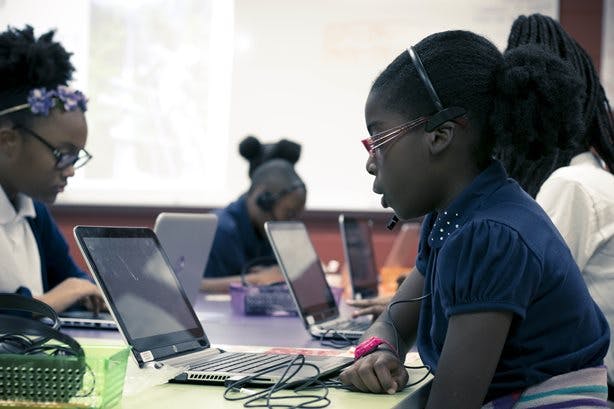Five reasons why struggling readers benefit from using technology
This guest blog post comes from Kristine Scharaldi, an education consultant and instructional coach with a specialization in the fields of educational technology, Mind-Brain-Education, Universal Design for Learning (UDL), and 21st Century Skills/Global Education.
With over 20 years of experience providing customized professional development and training for educators, we turned to Kristine to hear how technology can benefit struggling readers.
If you want to support your struggling students through the help of education technology, you won't want to miss Kristine's post!
The causes of reading challenges are often varied and complex. While not a silver bullet, digital tools can provide alternative methods to try with students in large, small and individual settings. Here are some significant ways that technology can help your struggling readers:
Increase interest and motivation
Technology can be a really good motivational tool for a struggling reader. He or she may prefer digital text and engaging in multimedia reading activities. One method to spark enthusiasm for reading is through “teaser” videos. The Book Trailers for Readers website offers a collection of teacher and student-created “commercials” for highly-recommended books. You and your students can make your own recordings using tech tools such as Animoto, Adobe Spark and iMovie.
Creating community around books can also boost student interest. The “Global Read Aloud” project connects classrooms around the world that are reading the same book to share responses. Another exciting method is video conferencing. Platforms such as Google Hangouts and Skype can connect students with authors and other classes to discuss what they are reading.
Additional opportunities to build background knowledge
One factor that influences reading comprehension is the background the reader brings to the text. Through technology students can access images and other content to help expand their knowledge of time periods, locations, and contexts. For example, before reading the novel The Outsiders, students can see pictures from the 1960s showing clothing teenagers wore, types of cars they drove, and scenes from Oklahoma to deepen their understanding of the story.
For students reading independently, teachers can place QR codes in books that link to related media. Students can scan the code with a mobile device to learn more about the book. I have inserted a QR code on the book Al Capone Does My Shirts that links to a video tour of Alcatraz, showing the exact places described in the story. (A free tool I use to generate QR codes is www.qrstuff.com.)
Provide multimedia options
There are different ways for students to engage and interact using technology, offering more opportunities to overcome reading challenges. Readers may listen to an audio version of a book and follow along with printed text. Digital text on a computer, tablet, or smartphone can be spoken aloud. A challenging word on a page of a website or ebook may be selected and pronounced. Settings are adjustable to ensure that the speed of the spoken text and voice type are comfortable for the child. Read&Write, a literacy toolbar from Texthelp, provides students with many of these features (and more).
Many apps and websites provide alternatives for students to experience text. Another great example of this is the site My Shakespeare. This site offers interactive text versions of plays accompanied by media such as interviews with characters, performances and pop-up notes that appeal to a 21st century learner. Digital products like this give students additional channels to understand, experience, and enjoy difficult text.
Embedded supports to empower readers
Readers of digital text have customizable options not available in paper-based print. Supports can be used with various platforms and websites to remove barriers when engaging with text. These features enable students to develop skills independently and avoid having to interrupt their reading when they need help. An example of a tool that offers many types of supports to developing readers is Fluency Tutor for Google. Students can record themselves reading passages aloud, play back their recording to hear what they need to work on, and quickly access text-to-speech, dictionary, picture dictionary and translate tools to help them practice and improve their fluency and comprehension.
The ability to adjust the way text is presented on the screen can make a huge difference for a struggling reader. It’s simple to change the font size and style to find something more readable. Students with dyslexia, for example, might benefit from switching to the Open Dyslexic typeface. The platform Newsela provides over 1,000 articles on a wide variety of topics that can be modified by reading level. Each article is offered at five different Lexile levels, allowing teachers and students to access the version of the text that best meets the needs of the reader.
Enhanced ways to connect and interact with text
Technology can support readers through the added tools and features accessible with digital text. One available option is digital sticky notes to annotate text. These can be color-coded for purposes such as text evidence, inferencing, analysis, etc. In addition, students can use a digital highlighter. A student can choose a color and specific text to be highlighted on a page. This can help indicate a place where he or she struggled. The teacher can encourage the child to highlight particular words or passages based on a skill that they are working on. The Read&Write toolbar has a digital highlighter feature that can also be used to organize research or create vocabulary lists.
No matter what challenges your readers face, digital tools can provide options and supports to try. What have you found helpful for your struggling readers? Does technology have a big part to play? Please comment below!

